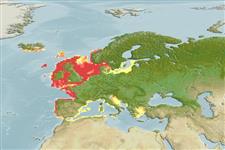Common names from other countries
>
Gadiformes (Cods) >
Gaidropsaridae (Rocklings)
Etymology: Gaidropsarus: Greek, ga, ge = the earth + Greek, ydro = water + Greek psaros = speckled, starling (Ref. 45335).
Environment: milieu / climate zone / depth range / distribution range
экология
морской демерсальный; немигрирующий; пределы глубины 20 - 120 m (Ref. 35388). Temperate; 64°N - 34°N, 23°W - 27°E
Northeast Atlantic: central Norwegian coast and the Faeroe Islands southwards through the North Sea and around the British Isles to the region around the Straits of Gibraltar. Reported from Iceland (Ref. 12462). Also in the western and northern coasts of the Mediterranean.
Size / Вес / Возраст
Maturity: Lm ? range ? - ? cm
Max length : 60.0 cm TL самец/пол неопределен; (Ref. 1371); common length : 25.0 cm TL самец/пол неопределен; (Ref. 3397)
колючие лучи спинного плавника (общее число) : 0; колючие лучи анального плавника: 0. First dorsal ray followed by a row of small, fleshy filaments. Color is varies from dusky to pale. Fin coloration varies geographically in the Western Atlantic, with southern specimens having more dark blotches than northern ones (Ref. 1371). One barbel on the lower jaw and two on the snout. Large chocolate brown spots on head and body (Ref. 35388).
Found on rocky bottoms but also on mud, sand and gravel. Feed on shrimps, crabs, isopods, small fish, mollusks and polychaetes (Ref. 1371). Spawn during spring and summer in the Mediterranean. Eggs and larvae are pelagic (Ref. 1371).
Life cycle and mating behavior
Maturities | размножение | Spawnings | Egg(s) | Fecundities | личинки
Cohen, D.M., T. Inada, T. Iwamoto and N. Scialabba, 1990. FAO species catalogue. Vol. 10. Gadiform fishes of the world (Order Gadiformes). An annotated and illustrated catalogue of cods, hakes, grenadiers and other gadiform fishes known to date. FAO Fish. Synop. 125(10). Rome: FAO. 442 p. (Ref. 1371)
Статус Красного Списка МСОП (Ref. 130435)
CITES (Ref. 128078)
Not Evaluated
Угроза для людей
Harmless
Использование человеком
рыболовство: не имеет хозяйственного значения
дополнительная информация
инструменты
Специальные отчеты
Скачать в формате XML
ресурсы в Интернет
Estimates based on models
Preferred temperature (Ref.
115969): 7.1 - 12.6, mean 9.6 (based on 254 cells).
Phylogenetic diversity index (Ref.
82804): PD
50 = 0.5001 [Uniqueness, from 0.5 = low to 2.0 = high].
Bayesian length-weight: a=0.00490 (0.00304 - 0.00790), b=3.01 (2.87 - 3.15), in cm Total Length, based on LWR estimates for this species & (Sub)family-body (Ref.
93245).
Trophic level (Ref.
69278): 3.5 ±0.4 se; based on diet studies.
устойчивость к внешним воздействиям (Ref.
120179): средний (среднего размера), минимальное время удвоения популяции 1.4-4.4 года (tmax=6).
Fishing Vulnerability (Ref.
59153): Moderate vulnerability (44 of 100).
